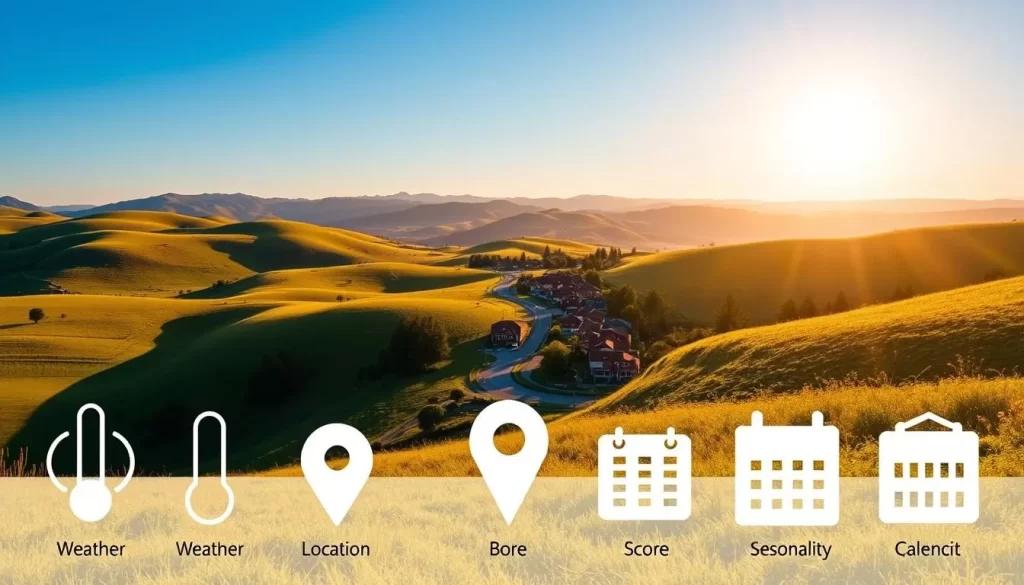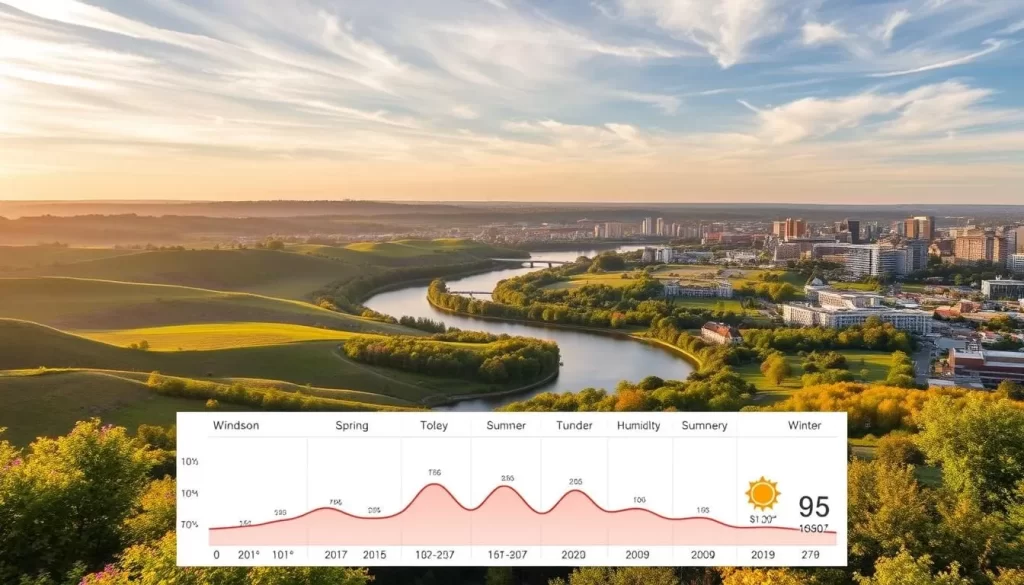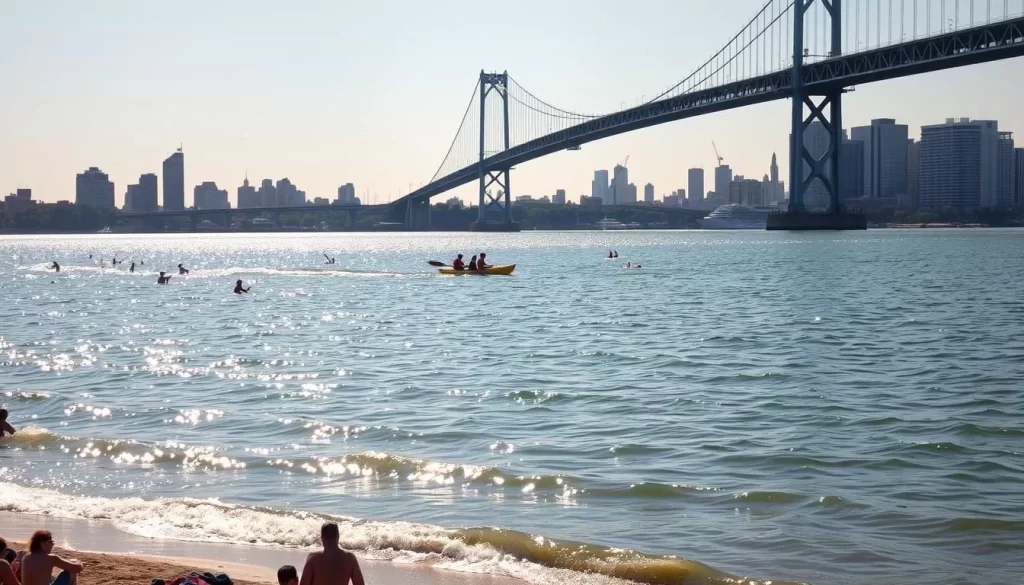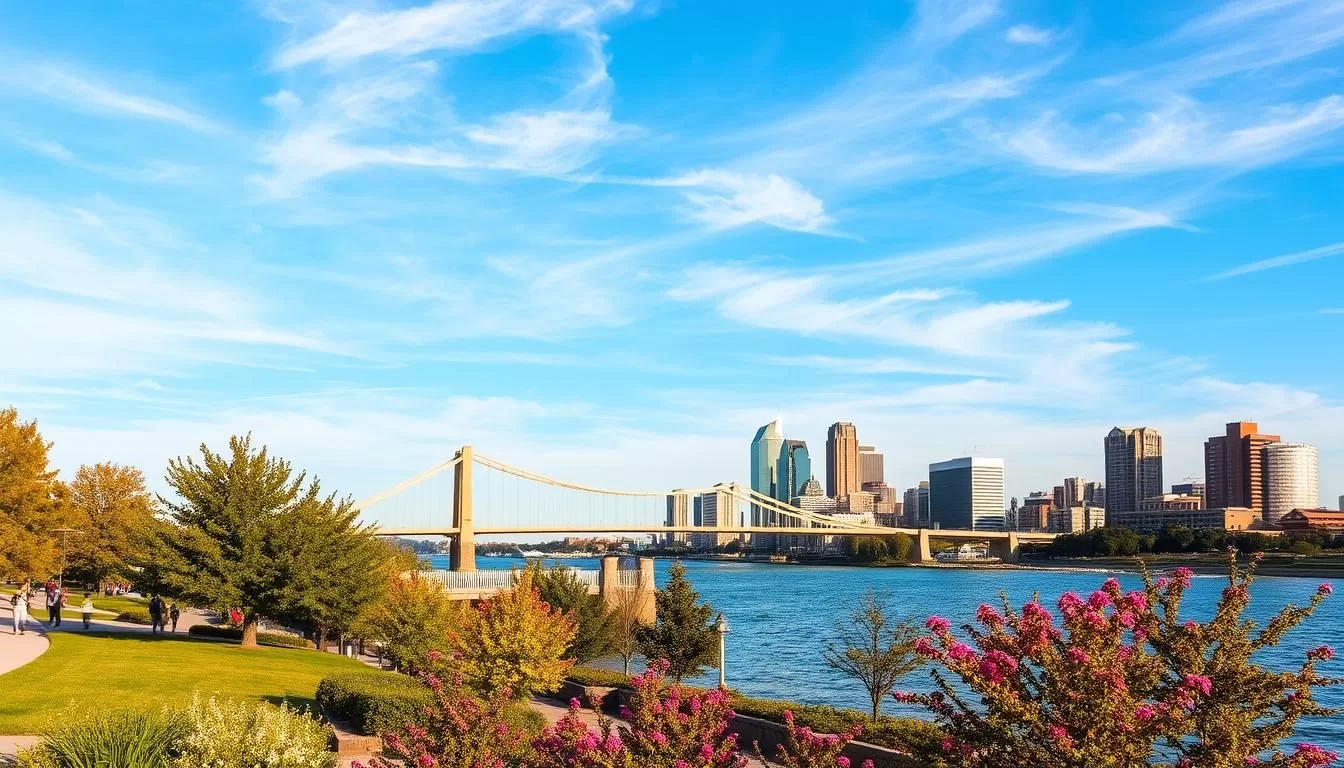Planning your next getaway? Choosing the best time to visit Windsor can make all the difference. With temperatures ranging from 20°F to 83°F throughout the year, the city offers a variety of seasonal experiences.
If you’re looking to enjoy warm-weather activities, the period from mid-June to mid-September is ideal. This is when you can fully explore outdoor attractions and local events. Whether you’re strolling along the riverfront or attending festivals, the weather is on your side.
This guide will help you decide when to visit Windsor based on your preferences. From sunny summers to crisp autumns, each season brings its own charm. Let’s dive into the details to make your trip unforgettable!
Overview of Windsor’s Year-Round Weather
Seasonal changes play a big role in shaping your travel experience. Understanding the climate here can help you plan your trip better. The weather varies significantly throughout the year, offering distinct experiences each month.
General Climate Patterns
The city experiences a humid continental climate, with cold winters and warm summers. The average temperature has increased by almost 1°C since 1940, reflecting broader climate trends. By 2050, the average annual temperature is predicted to rise by 2.5°C to 3.7°C.
Precipitation is also on the rise, with winter and spring becoming significantly wetter. Summer, however, may see a slight decline in rainfall. These changes highlight the importance of staying updated on weather forecasts.
Seasonal Weather Highlights
Winter brings cold temperatures, often dropping below freezing. Snowfall is common, making it ideal for winter sports enthusiasts. Spring sees a gradual warming, with increased rainfall and blooming landscapes.
Summer is warm and sunny, with temperatures often exceeding 30°C. This is the perfect time for outdoor activities and festivals. Fall offers crisp air and colorful foliage, making it a favorite for many visitors.
| Month | Average High (°C) | Average Low (°C) | Precipitation (mm) |
|---|---|---|---|
| January | -1 | -8 | 60 |
| April | 14 | 3 | 80 |
| July | 28 | 18 | 90 |
| October | 16 | 7 | 75 |
Knowing these patterns can help you choose the best time to visit. Whether you prefer warm summers or snowy winters, the city has something for everyone.
Key Factors Influencing Your Trip
Several elements come together to influence your journey, from weather to tourist activity. Understanding these factors helps you plan a trip that’s both enjoyable and hassle-free. Let’s explore how temperature, precipitation, and tourism scores shape your experience.
Temperature and Perceived Comfort
The actual temperature doesn’t always reflect how it feels outside. Perceived temperature considers humidity and wind chill, giving you a better idea of comfort levels. For example, a 75°F day with high humidity can feel much warmer.
This difference matters when planning outdoor activities. A sunny day might seem perfect, but high humidity can make it uncomfortable. Always check the perceived temperature to avoid surprises.
Precipitation, Cloud Cover, and Tourism Scores
Rain and clouds can significantly impact your plans. High precipitation levels might limit outdoor adventures, while clear skies enhance them. Cloud cover also affects the overall mood of your trip, making sunny days more appealing.
Tourism scores rate days based on ideal conditions for visitors. These scores combine weather data with tourist activity trends, helping you choose the best times to explore.

| Factor | Impact |
|---|---|
| Perceived Temperature | Determines comfort levels for outdoor activities. |
| Precipitation | Affects the feasibility of outdoor plans. |
| Tourism Score | Indicates ideal days for sightseeing and events. |
By balancing these elements, you can plan a trip that aligns with your preferences. Whether you prefer sunny skies or fewer crowds, these factors provide a clearer picture for your journey.
Understanding Seasonal Temperature Changes
Temperature shifts throughout the year can greatly impact your travel plans. Knowing the average high and average low for each season helps you prepare better. This section breaks down how temperatures vary and how humidity affects your comfort.
Average Highs and Lows
Daily temperatures fluctuate significantly between seasons. In July, the average high reaches around 82°F, perfect for outdoor activities. In contrast, January sees an average low of about 21°F, making it ideal for winter sports.
These variations are crucial when planning your trip. For example, spring temperatures range from 50°F to 59°F, offering mild weather for sightseeing. Fall brings cooler air, with temperatures dropping to 54°F, creating a crisp, refreshing atmosphere.
Perceived Temperature and Humidity Effects
Humidity plays a big role in how temperatures feel. A 75°F day with high humidity can feel much warmer, while low humidity in winter makes the cold feel sharper. This perceived temperature is essential to consider when packing or planning outdoor activities.
For instance, summer warmth can feel intense due to higher humidity levels. On the other hand, winter chill might feel more biting in dry conditions. Understanding these effects ensures you stay comfortable throughout your trip.
| Season | Average High (°F) | Average Low (°F) | Humidity Level |
|---|---|---|---|
| Summer | 82 | 64 | High |
| Winter | 34 | 21 | Low |
| Spring | 59 | 41 | Moderate |
| Fall | 64 | 46 | Moderate |
By understanding these seasonal changes, you can plan your trip more effectively. Whether you’re packing for summer heat or winter chill, this guide ensures you’re prepared for any weather.
Detailed Monthly Weather Breakdown
Choosing the right month for your trip can make all the difference in your experience. Each month brings unique weather patterns that influence travel conditions. Whether you’re planning for snow-filled adventures or sunny days, this breakdown will help you decide the best time visit.

Cold Season Insights
Winter months are marked by chilly temperatures and frequent snowfall. From December to February, average lows often drop below freezing, creating ideal conditions for winter sports. Snowfall is common, with January being the coldest month, averaging around 32°F during the day and 19°F at night.
If you enjoy crisp air and snowy landscapes, this is the perfect time to visit. However, be prepared for shorter daylight hours and potential travel delays due to weather conditions.
Warm Season Highlights
From late May through September, the weather is consistently warm and inviting. July is the hottest month, with average highs reaching 83°F and lows around 65°F. This period is ideal for outdoor activities, festivals, and exploring local attractions.
Rainfall is relatively low during these months, making it easier to plan outdoor adventures. Whether you’re hiking, biking, or attending events, the warm season offers plenty of opportunities to enjoy the sunshine.
Transitional months like spring and fall provide moderate conditions. Spring temperatures range from the 50s to 60s°F, while fall brings cooler air and colorful foliage. These seasons are perfect for those who prefer milder weather and fewer crowds.
By understanding these monthly patterns, you can choose the best time to visit based on your preferences. Whether you’re chasing snow or sunshine, this guide ensures you’re well-prepared for your trip.
Daily and Hourly Temperature Trends
Understanding hourly temperature trends can help you make the most of your day. Whether you’re planning outdoor activities or simply exploring, knowing how temperatures shift ensures a more comfortable experience. Let’s dive into the details of morning versus afternoon temperatures and how extreme weather hours can impact your plans.
Morning Versus Afternoon Temperatures
Temperatures can vary significantly from sunrise to sunset. Mornings are typically cooler, with average lows ranging from 50°F to 60°F, depending on the season. As the day progresses, temperatures rise, peaking in the early afternoon. This is when you’ll experience the warmest part of the day, often reaching highs of 75°F to 85°F in summer.
These shifts affect your daily activities. For example, mornings are ideal for brisk walks or jogging, while afternoons are better suited for relaxing by the pool or enjoying shaded areas. By aligning your schedule with these trends, you can stay comfortable and make the most of your time.
Insights on Extreme Weather Hours
Extreme weather conditions often occur during specific hours. In summer, the hottest part of the day is usually between 1 PM and 4 PM, when temperatures can feel even higher due to humidity. During winter, the coldest hours are typically early morning, just before sunrise.
Understanding these patterns helps you plan better. For instance, avoid strenuous outdoor activities during peak heat or cold hours. Instead, opt for indoor attractions or plan breaks during these times. This way, you can enjoy your day without discomfort.
By paying attention to hourly temperature trends, you can optimize your schedule for maximum enjoyment. Whether you’re exploring or relaxing, these insights ensure a smoother and more enjoyable experience.
Windsor, Ontario: Best Months for a Weather-Savvy Trip
Deciding when to visit can significantly enhance your travel experience. Choosing the best time visit ensures you make the most of your trip, whether you’re exploring outdoor attractions or attending local events. The time year you choose plays a crucial role in shaping your journey, from weather conditions to crowd levels.

Weather data and tourism scores converge to highlight the optimal travel periods. For example, the months from May to September offer warm temperatures, averaging between 70°F and 83°F, making them ideal for outdoor activities. These months also align with peak tourism scores, ensuring you enjoy the best conditions for sightseeing and events.
Here’s a quick summary to help you decide:
- Spring (May-June): Mild temperatures in the 50s and 60s°F, perfect for exploring without the summer crowds.
- Summer (July-August): Warm and sunny, with average highs reaching 83°F, ideal for festivals and outdoor fun.
- Fall (September): Crisp air and colorful foliage, offering a picturesque backdrop for your adventures.
Factors like degree variations and perceived comfort also influence travel decisions. For instance, July’s average high of 83°F might feel warmer due to humidity, while January’s average low of 19°F creates a chilly but cozy atmosphere for winter activities.
By comparing different months based on detailed weather and tourism data, you can choose the best time visit that aligns with your preferences. Whether you’re chasing sunny skies or snowy landscapes, the right time year ensures a memorable trip.
Best Time for Outdoor Activities and Tourism
Maximizing your outdoor adventures starts with choosing the right time. Understanding tourism scores and weather conditions can help you plan the perfect trip. These scores combine factors like temperature, precipitation, and crowd levels to highlight the best periods for exploration.
Tourism Score and Ideal Conditions
Tourism scores are calculated based on weather data and visitor trends. They help identify the most comfortable and enjoyable times to travel. For example, mid-June to mid-September offers warm temperatures and minimal rain, making it ideal for outdoor fun.
July and August are the hottest months, with average highs reaching 83°F. These months also have the highest tourism scores, ensuring you enjoy the best conditions for sightseeing and events.
Beach/Pool Score and Hot-Weather Activities
If you’re planning water-based activities, the beach/pool score is a key metric. This score reflects the best times for swimming, sunbathing, and other summer pastimes. High temperatures in July and August make these months perfect for enjoying the water.
Here are some activities that flourish during this period:
- Exploring local festivals and outdoor concerts.
- Hiking or biking along scenic trails.
- Relaxing by the pool or at nearby beaches.
By aligning your plans with these scores, you can optimize your travel experience. Whether you’re chasing sunny skies or vibrant events, the right timing ensures a memorable trip. For more insights on domestic destinations, check out this guide.
Planning for Rain, Snow, and Cloud Cover
Weather conditions can make or break your travel plans, especially when it comes to rain, snow, and cloud cover. Understanding how these elements vary throughout the year helps you prepare better and avoid surprises. Let’s explore the wet and dry seasons and how cloud cover can influence your experience.
Understanding Wet and Dry Seasons
The wetter season typically runs from late March to early October, with increased chances of rain and higher precipitation levels. During this period, you can expect an average of 10 to 12 rainy days per month, making it essential to pack waterproof gear. On the other hand, the drier season from October to March sees fewer rainy days, averaging around 6 to 8 per month.
These seasonal changes affect outdoor activities. For example, hiking in the rain can increase calorie burn and improve skin health due to cleaner air. However, heavy rainfall can also lead to saturated ground, increasing the risk of falling trees or rocks.
How Cloud Cover Affects Your Visit
Cloud cover plays a significant role in your travel experience. Sunny days are ideal for outdoor events and sightseeing, while overcast skies can dampen the mood. For instance, clear skies during the fall season enhance the visibility of vibrant foliage, making it a favorite time for many travelers.
Cloudy conditions can also impact visibility and wildlife sightings. Hiking in the rain often results in increased visibility of greenery and wildlife, offering a unique experience. However, prolonged cloud cover might limit your ability to enjoy outdoor photography or scenic views.
Here are some tips to help you plan:
- Monitor weather forecasts throughout the year to stay updated on rain chances.
- Pack waterproof clothing and gear, especially during the wetter season.
- Plan indoor activities as backups for rainy days.
By understanding these patterns, you can make informed decisions about when to visit and what to pack. Whether you’re exploring or enjoying summer festivals, being prepared ensures a smoother trip.
Impact of Humidity and Wind on Your Experience
Your comfort during travel is heavily influenced by humidity and wind. These factors can shape your outdoor activities, from walking tours to dining al fresco. Understanding how they work ensures a more enjoyable trip.
Humidity Comfort Levels Explained
Humidity affects how temperatures feel. High humidity can make warm days feel hotter, while low humidity can make cold days feel sharper. For example, a 75°F day with high humidity can feel closer to 85°F.
This perceived temperature is crucial for planning. If you’re exploring outdoors, check humidity levels to avoid discomfort. Pack lightweight, breathable clothing for humid days and layer up for dry, chilly conditions.
Wind Speed and Direction Considerations
Wind can either cool you down or make conditions harsher. The average wind speed varies throughout the year, with January being the windiest month and August the calmest. Gusts can disrupt outdoor activities, while steady breezes can provide relief on hot days.
Here’s how to prepare for windy conditions:
- Check wind speed forecasts before planning outdoor activities like walking tours or picnics.
- Pack windproof jackets or layers for high-wind days.
- Choose sheltered spots for outdoor dining to avoid discomfort.
By understanding these patterns, you can optimize your travel plans. Whether it’s a breezy summer day or a gusty winter afternoon, being prepared ensures a smoother experience.
Water Temperature and Its Effect on Outdoor Fun
Water temperature plays a key role in shaping your outdoor adventures. Whether you’re swimming, boating, or simply relaxing by the shore, the warmth of the water can make or break your day. Understanding seasonal changes in water temperature helps you plan better and enjoy your activities to the fullest.

Seasonal fluctuations in water temperature are significant. In August, the water warms up to around 74°F, making it ideal for swimming and water sports. In contrast, February sees cooler temperatures, often dropping below 40°F, which is better suited for winter activities like ice fishing.
Data from local weather stations shows these trends clearly. For example, July and August consistently have the warmest water, while December and January are the coldest. This information is crucial for planning your trip, especially if water-based activities are a priority.
Here’s a quick breakdown of water temperature trends:
| Month | Average Water Temperature (°F) |
|---|---|
| February | 38 |
| May | 55 |
| August | 74 |
| November | 48 |
If you’re planning a visit, the best time year visit for water activities is mid-summer. Warm water temperatures and sunny skies create perfect conditions for swimming, boating, and other outdoor fun. For those who prefer cooler weather, late spring and early fall offer milder temperatures for kayaking or paddleboarding.
Here are some practical tips for enjoying water activities based on temperature data:
- Pack appropriate gear, like wetsuits for cooler water or sunscreen for warmer days.
- Check local weather stations for real-time updates on water conditions.
- Plan activities early in the day during summer to avoid peak heat.
By understanding these patterns, you can make the most of your trip. Whether you’re diving into warm summer waters or enjoying the crisp air of fall, the right water temperature ensures a memorable experience. For more insights on how climate change impacts water systems, visit this guide.
Tips for Packing Based on Seasonal Variations
Packing smart can make your trip more enjoyable and stress-free. With weather conditions varying throughout the year, knowing what to bring ensures you’re prepared for anything. Historical data shows that temperatures and precipitation levels can shift significantly, so planning ahead is key.
Clothing Essentials for Each Season
Layering is your best friend when packing for different seasons. In winter, focus on thermal wear, heavy coats, and waterproof boots to stay warm and dry. Spring calls for light jackets, sweaters, and rain gear, as the average temperature ranges from 50°F to 59°F.
Summer requires breathable fabrics like cotton and linen, along with sunscreen and hats to protect against the sun. Fall is perfect for cozy sweaters, scarves, and comfortable walking shoes, as temperatures drop to around 54°F.
Travel Accessories for Weather Preparedness
Don’t forget to pack accessories that adapt to sudden weather changes. A compact umbrella and a lightweight rain jacket are must-haves for rainy days. For sunny days, sunglasses and a reusable water bottle will keep you comfortable.
Other essentials include a portable charger, a travel-sized first aid kit, and a weather-resistant backpack. These items ensure you’re ready for any situation, whether you’re exploring the city or hiking a mile from your hotel.
By reviewing the guide’s weather data and packing accordingly, you can enjoy your trip without worrying about the elements. Being prepared for seasonal variations ensures a smoother and more enjoyable experience.
Comparison with Nearby Destinations
Exploring nearby destinations can add depth to your travel plans. When deciding where to visit, comparing cities like Windsor and Detroit can help you choose the best spot for your year visit. Both cities offer unique experiences, but their weather and attractions differ significantly.
How Windsor Stands Out
Windsor’s climate is milder compared to Detroit, making it a more comfortable destination for outdoor activities. The average temperature in Windsor during the summer is around 82°F, while Detroit often experiences hotter days. This makes Windsor ideal for those who prefer moderate warmth.
Windsor also boasts a vibrant waterfront, offering scenic views and recreational opportunities. The city’s proximity to the Detroit River provides a unique blend of natural beauty and urban charm. These features make Windsor a standout choice for your seasonal getaway.
Overlap with Detroit’s Attractions
While Windsor has its charm, Detroit offers a different set of attractions. Known for its rich history and cultural landmarks, Detroit is a hub for music and art enthusiasts. The city’s weather, however, can be more extreme, with colder winters and hotter summers.
Both cities share some similarities, such as their love for festivals and outdoor events. However, Windsor’s milder climate often makes it a more comfortable option for year-round activities. Here’s a quick comparison of their key features:
| Feature | Windsor | Detroit |
|---|---|---|
| Average Summer Temperature | 82°F | 85°F |
| Winter Activities | Mild, fewer snow days | Cold, frequent snowfall |
| Tourism Highlights | Waterfront, parks | Museums, music venues |
By comparing these datum, you can decide which city aligns with your travel preferences. Whether you prefer Windsor’s mild climate or Detroit’s cultural richness, both destinations offer unique experiences for your year visit.
Conclusion
Your travel experience can be greatly enhanced by understanding the seasonal weather patterns. From warm summers to crisp autumns, each season offers unique opportunities for exploration. Using tourism scores and detailed weather data ensures you pick the ideal time for your visit.
Summer months are perfect for outdoor activities, with temperatures averaging 82°F and minimal rain. Fall brings cooler air and vibrant foliage, creating a picturesque backdrop for your adventures. Winter, though chilly, offers snowy landscapes ideal for cozy getaways.
Plan your trip with confidence by reviewing seasonal highlights and tourism scores. Whether you’re exploring local attractions or enjoying the region’s charm, being prepared ensures a memorable journey. For more unique experiences, check out the diverse attractions of Windsor Essex.
The above is subject to change.
Check back often to TRAVEL.COM for the latest travel tips and deals.
Here are some Tours & Sightseeing suggestions that might pique your interests!






